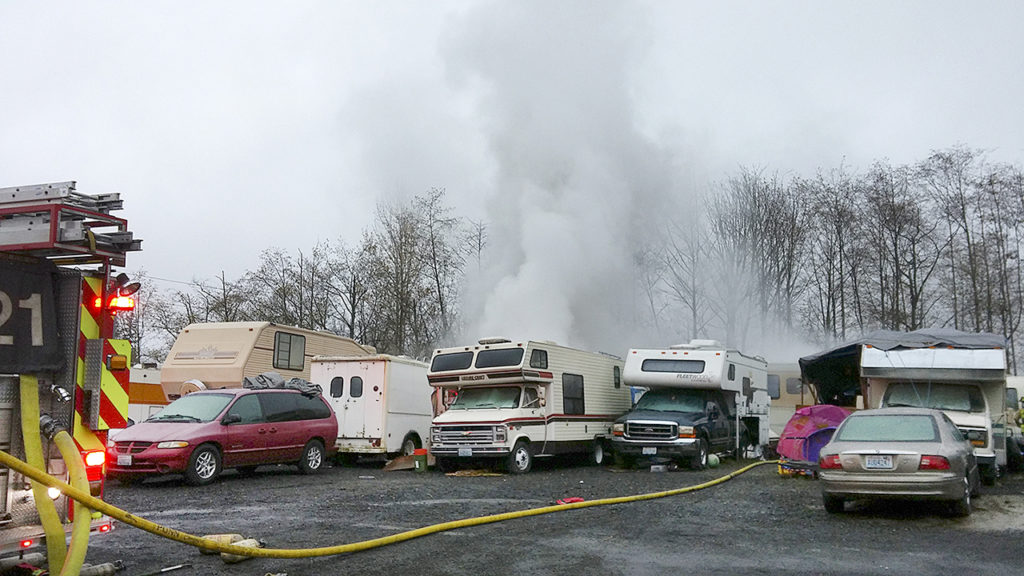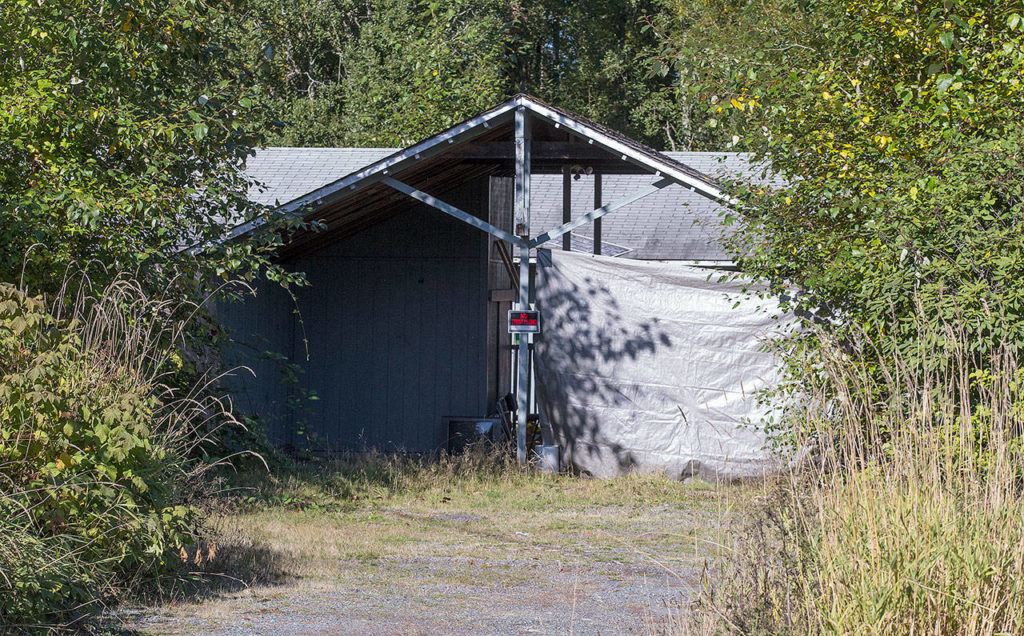MALTBY — Crews spent weeks grading and prepping land for a future truck factory before annoyed neighbors started nosing around.
Jeff Salisbury was dumbfounded by what he discovered: The property owner never got permits for the work. By that time, heavy equipment operators had cleared an estimated eight acres of commercial land along Broadway Avenue in Maltby.
The case involving truck maker OSW Equipment & Repair is among the most glaring code violations to come to light in recent Snohomish County history. If Salisbury and other neighbors hadn’t piped up back in August, officials may have never launched an investigation.
“I think the only reason they did anything is they were being laughed at,” said Salisbury, who’s retired from a job in heavy construction. “They just need to get some more teeth in their enforcement.”
OSW’s president has declined interview requests.
When neighbors complain about nuisance properties or environmental damage, they expect to see problems solved. They’re often frustrated by the amount of time it takes, as well as a system that puts the burden on ordinary citizens to spur enforcement.
Talk to code officials in Snohomish County, and the scale of the safety and environmental problems also becomes apparent. So do their limited resources.
Complaint-driven
Four code enforcement officers are responsible for all of unincorporated Snohomish County, with the help of a supervisor and an administrative coordinator. Some 350,000 people live in those areas, about 44 percent of the county’s population.
Complaints come by phone, online, by email or by letter. Sometimes people show up to county offices in person.
The most common gripes have stayed steady over the years: grading without permits, junkyard conditions and people living illegally in travel trailers and motorhomes. Some types of complaints come in waves: dog kennels, wedding facilities and problems at roadside coffee stands were big several years ago. More recently, small-scale breweries have been a target of neighborhood annoyance.
Late last month, county code officers were working 923 active cases — more than 200 each. The locations ranged from the illegal junkyards and unpermitted buildings, in flood land on Ebey Island, to the Cascade foothills.
“The reality is we’re working cases all over the county all of the time,” said Josh Dugan, a division manager with the county planning department who oversees code enforcement. “We don’t have the resources to drive around the county to look for violations.”
Snohomish County relies on complaints to initiate code investigations. So do most other city and county governments in Washington. That helps blunt accusations of selective enforcement.
“ ‘Why me and not them?’ We hear it all the time,” Dugan said. “Our response is that we’re a complaint-driven system.”
They prefer to work with violators before resorting to penalties.
“We try to apply pressure as judiciously as necessary to obtain compliance,” Dugan said. “If that’s a simple phone call, that’s great. In most cases, people are quite reasonable. They don’t realize there’s a violation.”
It isn’t always so easy. Fines can top out at $10,000 per residential violation and $25,000 per commercial violation.
Often, code-enforcement officers find themselves being used by squabbling neighbors as an instrument of revenge.
Many complaints fall outside their authority. County code officers aren’t building inspectors and have no authority in landlord-tenant disputes. Animal control is handled by the county auditor.
Staffing has been a moving target. The department grew from just one officer in the early 1990s, to 10 plus administrative support within a decade. The department even had a 24/7 hotline in flusher times.
During the recession, staffing was halved from eight officers to four, where it remains today. In a draft budget for next year, County Executive Dave Somers has proposed adding a fifth.
“When we put codes on the books, people expect us to enforce them,” Somers said. “…When you have four people for the entire county, it’s hard to respond to citizens’ complaints and calls.”
Beyond land use
Some code cases overlap with law enforcement.
Chris Rose has spent nearly a decade trying to stop a situation festering at a vacant house next door to him on Highway 92, between Lake Stevens and Granite Falls. A nice family used to live there, Rose remembered. The house changed hands and has been vacant for years with out-of-state owners.
“I’ve seen weird people who don’t have any business being there,” Rose said.
Trash accumulates. Rose has called in reports of stolen cars. Deputies have shown up to chase away squatters.
“They’re back the next day because there’s nothing the police can do,” he said. “We haven’t given our public officials any authority.”
County fines have piled up: $20,000, related to accumulated junk and dangerous building conditions. But what’s most concerning to Rose is the kind of company the vacant house attracts.
“I’m not the police,” he said. “We’re not a vigilante society. We pay these people to help solve our problems and we don’t give them any authority.”
If Rose had his way, the place would be torn down.
That’s not a step the sheriff’s office can take.
“We can arrest people for illegal activity,” sheriff’s spokeswoman Shari Ireton said.
About a year ago, deputies notified the owner of the property next door to Rose that they suspect there was unlawful activity there.
“We sent a letter asking them to abate the nuisance, but I don’t believe we ever heard back,” Ireton said. “We have to follow what the civil statutes provide for us, or criminal laws.”
Deputies have their hands full with other nuisance properties. At any given time, they’re working up to 80 cases jointly with code enforcement, human services, the Snohomish Health District or the Snohomish County Fire Marshal.
“Each nuisance property presents a variety of challenges,” Ireton said. “The only way the government can address it is through partnerships. Law enforcement alone cannot address it. Code enforcement alone cannot address it.”
Illegal RV park
In unincorporated Lynnwood, deputies, code officers and health officials can point to some success.
Until recently, an illegal RV park was teeming on the east side of I-5, near the 164th Street exit. A shantytown of motorhomes and junked cars appeared on land zoned for single-family housing. Companies paid to park commercial equipment there, including a fleet of rental trucks. Raw sewage ran over the ground. The man who owned the property charged most tenants $150 per month to park there, court documents state.
A code officer who visited in mid-2016 documented “over 80 vehicles on the property” and at least 10 people “living in RVs and trailers which are not mobile.” A fire broke out in a camper in December, sending a woman to the hospital.
Nearby homeowners and businesses suspected people at the site of illicit drug use, mail theft, car prowls and burglaries. Illegal bulldozing and lean-to buildings caught code officers’ attention.
“It was a pretty egregious site with lots of people, lots of neighborhood complaints,” Dugan said. “In that case, I think we applied the appropriate amount of pressure within Snohomish County code to effect change.”
County officials had been trying to address code problems since 2014. Early this year, there were few signs of improvement. The health district went to court to improve sanitation. The court issued an injunction in March barring the owner or anyone else from living there.
Aerial photos that Washington State Patrol troopers took in May still showed at least 20 recreational vehicles on the property, court documents state. At least two heavy trucks and several smaller pieces of equipment were there as well, along with junked cars and a burned-out RV.
In June, the county filed its own lawsuit trying to force a cleanup.
The county has sent more than $60,000 in unpaid fines to collection agencies. That doesn’t include the cost of cleaning the property or restoring areas that were graded illegally.
Relatives now have legal authority over the property and made strides toward turning things around. A couple of trash containers and junked cars remain, but the land looks nothing like it did earlier this year. A sign at the fenced-off entrance warns: “COMPOUND IS CLOSED!! STAY OUT!! PRIVATE PROPERTY.”
Temporary fixes
At the Maltby construction site shut down for lack of permits, huge sheets of plastic now cover earthen berms. Grass sprouts from what was recently bare earth.
OSW has been working with the state Department of Ecology and the county to dig drainage systems, reseed the ground and take other short-term measures to keep dirt from washing away from the property, Dugan said.
The property owner, an LLC in which the truck maker has a controlling stake, also faces a county fine: $1,500.
The fines aren’t the only extra cost. Beyond the expense of installing temporary stormwater measures, permit fees are set to double. County officials initially said that could run an extra $35,000 or more. They now estimate it’s likely to be less than half that amount. Dugan said his staff determined that the doubling penalty would only apply to the grading permit in an amount proportionate to completed work, not to other permits that must be obtained at later stages of the project.
County and state officials report that they’re satisfied with the response since the problems came to light. Others aren’t.
Salisbury said the county’s penalties are hardly a deterrent to breaking the law, if it means avoiding months of construction delays and getting work done before the rainy season.
“These fines are a joke,” he said. “It’s chump change to them.”
Rikki King contributed to this report. Noah Haglund: 425-339-3465; nhaglund@herald net.com. Twitter:@NWhaglund.
Talk to us
> Give us your news tips.
> Send us a letter to the editor.
> More Herald contact information.



























